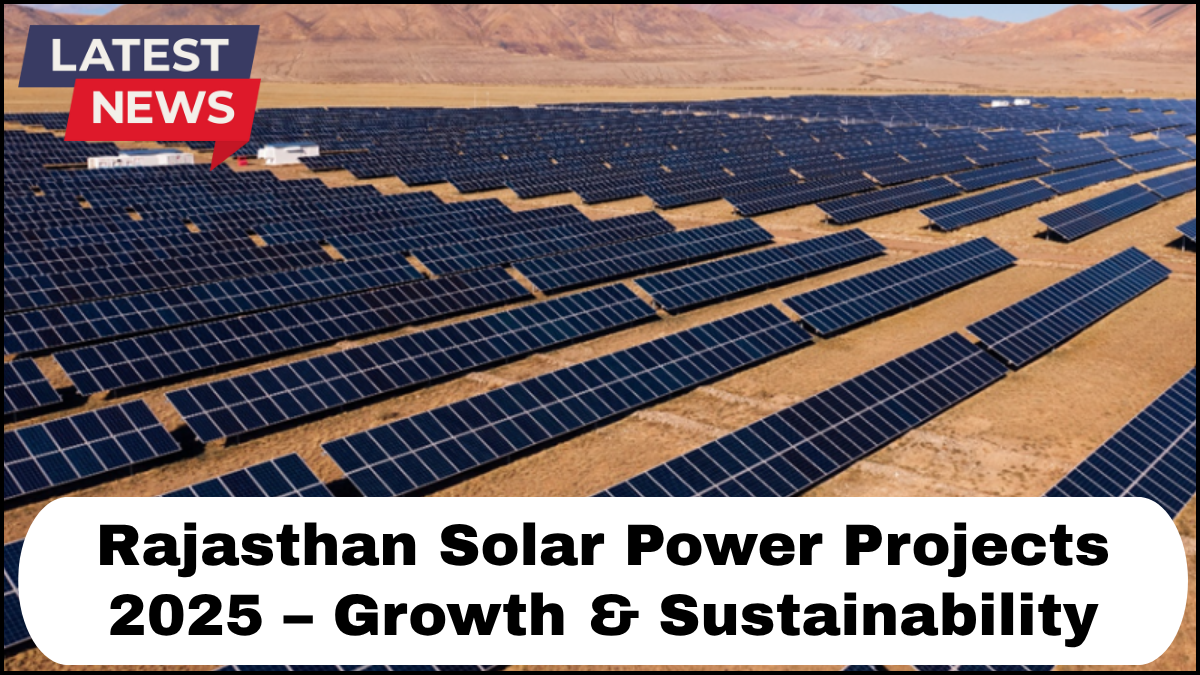Rajasthan is emerging as India’s solar powerhouse, and by 2025, its ambitious solar energy roadmap is expected to set new benchmarks in green energy development. With abundant sunlight, vast land availability, and strong policy support, the state is attracting both domestic and international investors at an unprecedented pace. This article explores the trajectory of Rajasthan solar projects 2025, shedding light on the factors fueling their growth and the sustainability measures shaping their future.

Why Rajasthan Leads India’s Solar Revolution
Rajasthan’s solar success is no accident. The state enjoys over 325 sunny days annually and boasts one of the highest solar radiation levels in India—between 5.6 to 6.0 kWh/m²/day. Combined with large expanses of arid, low-value land, Rajasthan presents an ideal landscape for utility-scale solar parks.
In 2021, Rajasthan overtook other Indian states to become the largest solar energy producer, and by 2025, its installed solar capacity is projected to exceed 30 GW. Key projects under development are spread across Bhadla, Jodhpur, Jaisalmer, and Barmer, with many tied to national transmission corridors enabling pan-India power distribution.
Key Rajasthan Solar Projects 2025
1. Bhadla Solar Park – Scaling Up Further
Bhadla remains the crown jewel of India’s solar infrastructure. As the world’s largest solar park, it already has a capacity of over 2,245 MW. Expansion plans under Rajasthan solar projects 2025 aim to push this figure beyond 3,000 MW, leveraging new tenders and advanced solar tracking technologies to maximize efficiency.
2. Fatehgarh and Nokh Solar Parks
The Fatehgarh and Nokh regions are quickly gaining attention. These parks are part of the state’s larger renewable energy strategy, with planned capacities exceeding 10 GW combined. They are being developed in phases and are supported by large-scale power purchase agreements (PPAs) with national power utilities and private corporations aiming to decarbonize.
3. Floating Solar Projects in Chambal and Jawai
To reduce land usage and water evaporation, Rajasthan is experimenting with floating solar installations on dams and reservoirs. The Chambal and Jawai river basins are key sites for pilot projects expected to contribute up to 200 MW by 2025.
Policy Support & Government Initiatives
Rajasthan’s solar boom is being propelled by clear and investor-friendly policies:
-
Rajasthan Solar Energy Policy 2019: Offers exemptions on electricity duty, land conversion charges, and wheeling/transmission charges for solar power producers.
-
Rajasthan Renewable Energy Corporation Limited (RRECL): Acts as the nodal agency for fast-tracking approvals and facilitating land allotments.
-
Ease of Doing Business: Digitized clearance systems and land banks have minimized bureaucratic delays.
In 2025, new incentives are expected for hybrid solar-wind projects and energy storage solutions, enhancing the grid’s resilience and flexibility.
Sustainability at the Core
The expansion of Rajasthan solar projects 2025 isn’t just about energy generation—sustainability is at the heart of the mission. Developers are incorporating the following practices:
-
Use of Robotic Dry Cleaning Systems: To conserve water in desert regions.
-
Dual-Use Land Models: Integrating agriculture and solar panels through agrivoltaics to support rural livelihoods.
-
Battery Storage and Smart Grids: To ensure efficient load management and 24/7 clean power supply.
-
Community Participation: Local employment initiatives and CSR programs aimed at uplifting rural communities near solar parks.
Economic Impact and Investment Trends
The Rajasthan solar ecosystem is attracting billions in investment. Global players like Adani Green Energy, ReNew Power, and SJVN have committed significant capital for Rajasthan solar projects 2025. This inflow is boosting local economies, creating thousands of direct and indirect jobs, and spurring related sectors such as transmission, manufacturing, and services.
Challenges and Solutions
While the growth is impressive, challenges remain:
-
Transmission Bottlenecks: Rapid capacity growth sometimes outpaces infrastructure. To address this, Rajasthan is expanding its intrastate green corridors and linking with the national grid.
-
Land Acquisition Disputes: To avoid delays, state agencies are prioritizing wasteland usage and pre-cleared land banks.
-
Intermittency of Solar Power: Hybrid systems and grid-scale battery installations are being deployed to stabilize power output.
The Road Ahead
Rajasthan’s solar story is far from over. By 2030, the state aims to produce 90 GW of renewable energy, with solar leading the charge. Rajasthan solar projects 2025 are just a major milestone in a broader vision to make the state not only India’s clean energy leader but a global renewable energy hub.
As the world races toward net-zero goals, Rajasthan’s aggressive push toward green energy development stands out as a model of scale, sustainability, and inclusivity.
Frequently Asked Questions (FAQs)
Q1. What is the total projected solar capacity in Rajasthan by 2025?
A: The total installed solar capacity in Rajasthan is expected to surpass 30 GW by 2025.
Q2. Which are the major solar parks being developed in Rajasthan?
A: Key parks include Bhadla, Fatehgarh, Nokh, and emerging floating solar projects in the Chambal and Jawai regions.
Q3. How is Rajasthan ensuring sustainability in its solar projects?
A: Through water-saving technologies, dual land-use models like agrivoltaics, battery storage systems, and local community engagement.
Q4. Who are the key players in Rajasthan solar projects 2025?
A: Major players include Adani Green Energy, ReNew Power, NTPC, and state-led initiatives via RRECL.
Q5. What policies support solar energy development in Rajasthan?
A: Rajasthan Solar Energy Policy 2019, land and duty exemptions, and infrastructure development like green energy corridors.
click here to learn more